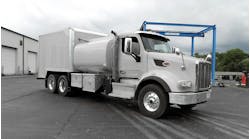Emission issues related to aboveground storage tanks continues to be in the forefront of storage terminal operations and were a topic at the International Liquid Terminals Association (ILTA) Operating Conference and Trade Show June 9-11 in Houston, Texas.
Discussing issues such as emission control, emission equipment maintenance, and new designs on the horizon were Rob Ferry of the TGB Partnership, Melissa Lenhart and Tim Wiley of John Zink Company LLC, and Morris Kline of HMT Inc.
Floating roof landing emissions can occur when the vapor space under the landed floating roof is vented to the head space above the deck and when the head space is vented to the atmosphere, said Ferry. Two modes of emissions can occur when the roof remains landed and when the tank is refilled.
Refilling storage tanks expels vapors from under the deck. The quantity of vapors residing under the deck prior to refueling depends on the stand-idle conditions. In addition, incoming liquid generates additional vapors so that even a completely vapor-free tank will have vapors in the air displaced from under the deck, Ferry said.
Emissions also can occur during tank cleaning and are generated by the degassing and cleaning procedures.
Ferry pointed out that estimating emissions from floating roof landings and tank cleanings can involve very complex calculations.
He added that the emissions that occur in landing and cleaning may mean permits are required. If the permits do not adequately cover all of an operation, they should be revised.
Control alternatives
Lenhart and Wiley discussed alternatives for vapor control in loading operations. There are advantages to vapor recovery systems because they can be installed in a hazardous area, have no ignition source, offer a positive return on investment, emit no additional pollutants, and require no supplemental fuel.
Two types of systems are dry vacuum pump regeneration and liquid ring vacuum pump regeneration. The dry pump system reduces power consumption, eliminates ethylene glycol seal fluid and associated components, decreases maintenance costs, produces no product contamination, and has greater flexibility in handling a variety of products.
Advantages of the liquid ring system include tolerance of solid and liquid slugs, a wide capacity range, and lower capital cost for large systems.
Weekly, monthly, and annual maintenance schedules should be established for all the pump and vapor combustion systems. Each type of pump requires specific maintenance procedures, but most will need the following: control panel lamp tests, pump lubrication checks, oil analysis, zero and span emission analysis, and vacuum and fault leak tests.
Roof emissions
Kline addressed options for managing emissions from internal floating roof tanks. The goal for all owners with internal floating roof tanks should be reducing evaporative losses, hazardous vapor emissions, and permitting issues. Owners now have roof options to reduce emissions, offset some landing losses, increase capacity, or trade emissions credits.
He pointed out that the Environmental Protection Agency (EPA) and state regulatory authorities have mandated a change in tank operation practices that include prohibiting floating roof landings except for change of service and cleaning/repairs. The EPA and state regulators suspect that roof landing losses have been under-reported.
A significant research and development project in early 2008 resulted in the aluminator full contact aluminum floating roof, which is a full contact roof design (in contact with liquid). All deck seams are seal welded to eliminate deck seam emissions. The roof qualifies as a welded seam roof under EPA's Tanks4 program. After deck seams are welded, seal welds are vacuum-box tested to ensure vapor tightness.
The overall design of the new roof is aluminum and weigh about two pounds per square foot, which is compatible with a cable suspension system to eliminate roof penetrations from roof support legs. It meets or exceeds design requirements of API650, Appendix H.
The roof has a unique panel design with each panel module fully factory tested for vapor tightness. It can be field inspected, if required.
In addition, there is no filler material to cause cleaning and gas freeing issues during inspection/repair cycles. The roof is strong enough to support metallic shoe primary seals and secondary seals, but the real payoff for owners is emission reductions, he said.








